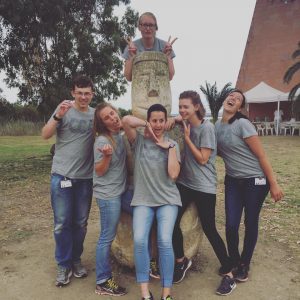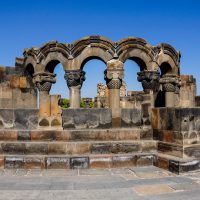 In the last post about the Archaeological Conservation trip to Sardinia, the Mont’e Prama Project was explained. You were introduced to what conservation is exactly, and the people involved. That post was only a snapshot into all that the Grove City students did while there. This post will give you a little bit more detail.
In the last post about the Archaeological Conservation trip to Sardinia, the Mont’e Prama Project was explained. You were introduced to what conservation is exactly, and the people involved. That post was only a snapshot into all that the Grove City students did while there. This post will give you a little bit more detail.
Our Little Town of Cabras
We did our work in the local Cabras museum, or Museo, as it is in Italian. In the United States, we are used to walking around museums that are huge, that could take literally days to fully explore and appreciate. The Museo in Cabras is minuscule when compared to our museums here in America. The entire Museo was built around a central courtyard, which is where we worked on the fragments. Visitors to the museum would walk through and watch us work. It was exciting and fun to get to see their fascination.
Our average day in Cabras contained a lot of walking, which was a good thing. Maria, our per sonal chef, kept us well fed on pasta. So none of us had an issue with walking some of it off. We would wake up in a little apartment, which we shared with our fellow students, put on our CCA work shirt, and walked 25 minutes to the Museo through town. Some days we would walk through the little town, but most days we would enjoy the sight of the lake as we walked along dirt roads to work. Once at the Museo, Francesca and Gian Mario – two young, funny, and friendly conservationists – would go over our tasks for the day.
sonal chef, kept us well fed on pasta. So none of us had an issue with walking some of it off. We would wake up in a little apartment, which we shared with our fellow students, put on our CCA work shirt, and walked 25 minutes to the Museo through town. Some days we would walk through the little town, but most days we would enjoy the sight of the lake as we walked along dirt roads to work. Once at the Museo, Francesca and Gian Mario – two young, funny, and friendly conservationists – would go over our tasks for the day.
The Daily Work
At the beginning, there was a lot of instruction with the dusting of fragments and their categorization. Later, our tasks included piecing fragments back together, and doing a detailed cleaning of the fragments with mild soap, mist, and scalpels. Most of the dirty work, dusting fragments and chiseling dirt chucks off of them with wooden sticks, was done outside under a white tent. While the sun could get extremely hot, the temperatures we had were just right,
We would work from 9 to about 10:45 a.m., and then get a 20-minute break to go across the street to get a coffee. This was also a great chance to use what little WiFi we could manage to find while abroad. At 1 in the afternoon, Maria would come deliver our lunch. Some days it was as simple as a sandwich, and other days (the best days) she brought us dishes deliciously complex, like fried eggplant lasagna.
Our afternoon work was the most tiresome, but often the most rewarding. There are few words adequate enough to describe the peace that comes from diligently working on a project while having a warm breeze blow against your cheek. It was a soothing routine which allowed one to enjoy the fresh air, sunshine, and company of those around.
At 4:30 p.m. we would start cleaning up our projects and putting everything away, storing the fragments in the Museo’s basement to stay secure, and washing up. We walked back home to the very welcome arms of a hot shower, and then headed over to the apartment of Dr. Nardi and all the staff for dinner. Sometimes we would skip the shower and head down to one of Sardinia’s exquisite beaches. It will always be exciting to say that I have swam in the crystal clear waters of a Mediterranean Island.
Evenings in Sardinia
These relaxed outdoors dinners were the best opportunities to converse with Dr. Nardi, Andreana, Francesca, and Gian Mario. Maria treated us to some delicious food, which usually came in three or four courses. After we were satisfied, and had enjoyed the fresh peaches, apples, and apricots, Dr. Nardi would tell us stories about all his different conservation projects. He spoke of how ISIS and Radical Islam were destroying art, statues, and architecture all over the Middle East. Dr. Nardi also talked about the work the he performed on art pieces. These pieces were in immediate threat of destruction. The students were given more detailed lectures on the finer points of this conservation.
After the discussions with Dr. Nardi, we walk back to our cozy little apartments to go to bed. Sometimes we would go out around town and enjoy all that Cabras had to offer. Our days contained so much more than I have written here. The moments spent working at the Cabras Museo were special, and they hold a very joyful place in my heart.
